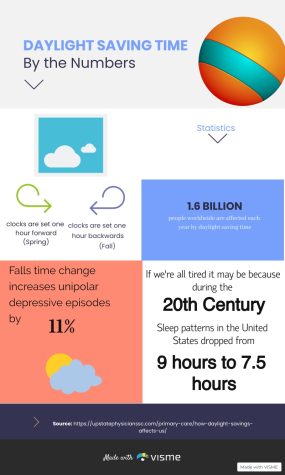Save the shine
Over the years, daylight savings time has brought great controversy in the U.S Congress. With the Sunshine Protection Act, daylight or standard time will remain permanent and bring an end to the draining time change twice a year. With this bill passed, deer crashes will reduce along with depression.
November 9, 2022
Twice a year, millions of Americans wake up and realize they need to change the time on their oven or watch. But over the years, Americans push to end this time change. In March of 2022, the Senate voted to put a stop next year to the changing of clocks, which supporters say will lead to brighter afternoons and increased economic activity.
U.S. Representative Frank Pallone, who obtains jurisdiction over the issue, said the House search for resolutions. Legislative aides do not expect U.S Congress to come to an agreement before the end of the year. Supporters in the Senate would need to reintroduce the bill next year if not approved by the end of the year. Daylight-saving time has occurred in nearly all of the United States since the 1960s. Year-round daylight saving appeared during World War Two and rose again in 1973.
Sunday, November 6 at 2:00 a.m., the United States resumed standard time. Pallone previously said he backs ending the clock-switching but still decides whether to support daylight or standard time as the permanent choice. Supporters also argue that if approved, the Sunshine Protection Act will allow children to play outdoors later, and reduce seasonal depression. It will also prevent a slight uptick in car crashes that typically occurs around time changes, espies incidents with deer.
“People should consider going to bed earlier to get an adequate amount of sleep. I also suggest temporarily curbing nighttime caffeine, alcohol, exercise and blue-light usage. Eating your evening meal earlier might help, too. Fortunately, most people will only struggle for a few days to a week,” clinical coordinator at East Cooper Medical Center Jennifer Mackenzie said.
They also point to studies suggesting a small increase in heart attacks and strokes after time change and argue the act could help businesses like golf courses draw customers into the evening. Critics, including the National Association of Convenience Stores, say it will force children to walk to school in darkness during the winter, since the measure delays sunrise by an hour in certain places.

“While I appreciate the extra hour I receive from daylight savings, it sometimes messes with my mental and state of mind. This morning when I woke up, I assumed it was 7:30a.m because of how bright it was so I rushed out of bed only to check my phone to see it was 6:40 a.m. It’s just an unnecessary adjustment,” senior Bryan Graham said.
Earlier this year, the White House declined to mention Biden’s opinion on making daylight-saving time permanent. Since 2015, close to 30 states have introduced or passed legislation to end the twice-yearly changing of clocks. The bill would allow Arizona and Hawaii, to remain on standard time, as well as American Samoa, Guam, the Northern Mariana Islands, Puerto Rico and the U.S. Virgin Islands.
States actually appear in favor of this new bill. So far, 16 U.S states have passed the Sunshine protection act to make daylight savings permanent according to a tally from the National Conference of State Legislatures. In 2021, Georgia Governor Brian Kemp signed a bill into law that would make daylight saving permanent.






